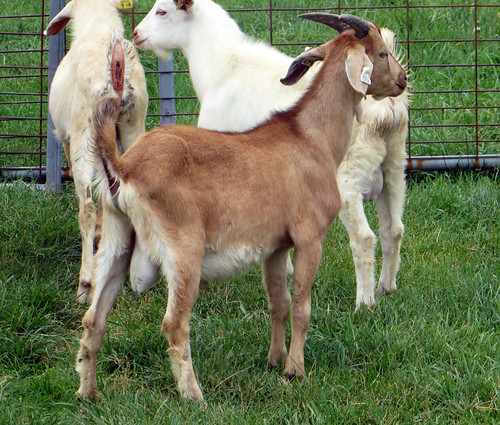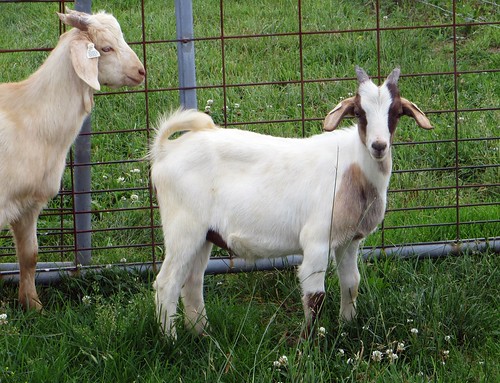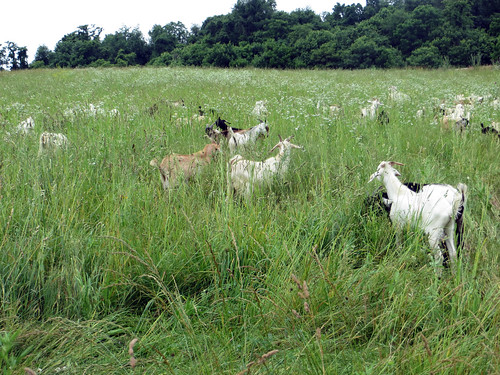Weight gain was quite variable during the first two weeks of the test. Gain ranged from -4.1 to 6.4 lbs. and averaged 0.30 ± 2.1 lbs. (136 ± 953 g). The median gain was 0.4 lbs. Average daily gain (ADG) ranged from -0.293 to 0.457 lbs. per day and averaged 0.020 ± 0.15 lbs. (9 ± 68 g) per day. The median ADG was 0.03 lbs. per day.
The large standard deviations (Stdev) are indicative of the variable gains made by the 77 goats in the test. Thirty-five percent (n=27) of the goats lost weight during the first two weeks of the test. Three goats maintained their weight. Forty-six goats (60%) posted positive weight gains for the period.
For the first 14-day period, #479, a Purebred Kiko consigned by Jill Zink from Indiana was the top-gainer. It gained 6.4 lbs. or 0.457 lbs. per day from June 6 until June 19. Other top gainers were #'s 431 and 456. 431 is a Purebred Kiko consigned by Gery Glover, a first-time consigner from Maryland. 456 is a New Zealand Kiko consigned by David Peters from North Carolina. #431 and 456 gained 0.314 and 0.300 lbs. per day, respectively. All goats from the consignments of Kendall Barnes (KY), P.J. Murphy (NJ), and John Smith (VA) gained weight.
There were no significant changes in FAMACHA©, body condition, coat condition, dag, and fecal consistency scores. FAMACHA© scores ranged from 1 to 4 and averaged 1.7 ± 0.6, compared to 1.6 two weeks ago. The median FAMACHA© score was 2. One goat required deworming. Body condition scores ranged from 2 to 3 and averaged 2.2 ± 0.2, the same as two weeks ago. The median body condition score was 2.0
Coat condition scores ranged from 1.5 to 2.5 and averaged 2.1 ± 0.2, slighter better than two weeks ago, as several goats had improved coat condition scores. Dag scores ranged from 0 (no fecal soiling) to 4 (significant fecal soiling) and averaged 0.1 ± 0.5. The median dag score was 0. Fecal consistency scores ranged from 1 (liquid) to 4 (solid pellets) and averaged 3.8 ± 0.6. The median fecal consistency score was 4. Only one goat presented with scours.
Individual fecal samples were collected from each goat. These samples were sent to Virginia State University for fecal egg count determination. A pooled fecal sample was collected from many goats. This sample will be sent to the Grazingland Animal Nutrition Lab (in Texas) for determination of diet quality. Additional samples will be taken during the test to determine the nutrient quality of the diet the goats are consuming.
After working, the goats were moved to a fresh pasture of mostly orchardgrass. The test remains in the "parasite challenge" phase. The purpose of this first six week phase is to evaluate the bucks for parasite resistance and resilience. In order to accomplish this goal, it is necessary that the goats face a sufficient parasite challenge.
To some extent, growth is a secondary consideration during this portion of the test. The second six weeks will serve as a "growth challenge," as the goats will be graze clean, nutritious, annual forages: millet, Sunn Hemp, and cowpeas. They will also be given a 0.5 g bolus of copper oxide wire particles at the end of the parasite challenge phase.
Download June 19 (d-14) report
The large standard deviations (Stdev) are indicative of the variable gains made by the 77 goats in the test. Thirty-five percent (n=27) of the goats lost weight during the first two weeks of the test. Three goats maintained their weight. Forty-six goats (60%) posted positive weight gains for the period.
 |
| Jill Zink's (Indiana) top-gaining Kiko buck. |
For the first 14-day period, #479, a Purebred Kiko consigned by Jill Zink from Indiana was the top-gainer. It gained 6.4 lbs. or 0.457 lbs. per day from June 6 until June 19. Other top gainers were #'s 431 and 456. 431 is a Purebred Kiko consigned by Gery Glover, a first-time consigner from Maryland. 456 is a New Zealand Kiko consigned by David Peters from North Carolina. #431 and 456 gained 0.314 and 0.300 lbs. per day, respectively. All goats from the consignments of Kendall Barnes (KY), P.J. Murphy (NJ), and John Smith (VA) gained weight.
There were no significant changes in FAMACHA©, body condition, coat condition, dag, and fecal consistency scores. FAMACHA© scores ranged from 1 to 4 and averaged 1.7 ± 0.6, compared to 1.6 two weeks ago. The median FAMACHA© score was 2. One goat required deworming. Body condition scores ranged from 2 to 3 and averaged 2.2 ± 0.2, the same as two weeks ago. The median body condition score was 2.0
 |
| Gery Glover's (Maryland) top-gaining buck |
Coat condition scores ranged from 1.5 to 2.5 and averaged 2.1 ± 0.2, slighter better than two weeks ago, as several goats had improved coat condition scores. Dag scores ranged from 0 (no fecal soiling) to 4 (significant fecal soiling) and averaged 0.1 ± 0.5. The median dag score was 0. Fecal consistency scores ranged from 1 (liquid) to 4 (solid pellets) and averaged 3.8 ± 0.6. The median fecal consistency score was 4. Only one goat presented with scours.
Individual fecal samples were collected from each goat. These samples were sent to Virginia State University for fecal egg count determination. A pooled fecal sample was collected from many goats. This sample will be sent to the Grazingland Animal Nutrition Lab (in Texas) for determination of diet quality. Additional samples will be taken during the test to determine the nutrient quality of the diet the goats are consuming.
 |
| Fresh pasture |
After working, the goats were moved to a fresh pasture of mostly orchardgrass. The test remains in the "parasite challenge" phase. The purpose of this first six week phase is to evaluate the bucks for parasite resistance and resilience. In order to accomplish this goal, it is necessary that the goats face a sufficient parasite challenge.
To some extent, growth is a secondary consideration during this portion of the test. The second six weeks will serve as a "growth challenge," as the goats will be graze clean, nutritious, annual forages: millet, Sunn Hemp, and cowpeas. They will also be given a 0.5 g bolus of copper oxide wire particles at the end of the parasite challenge phase.
Download June 19 (d-14) report











